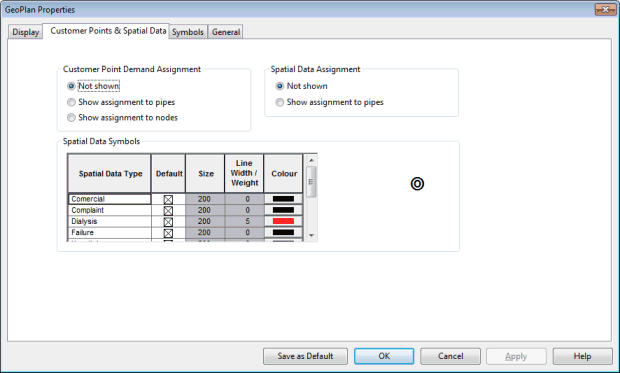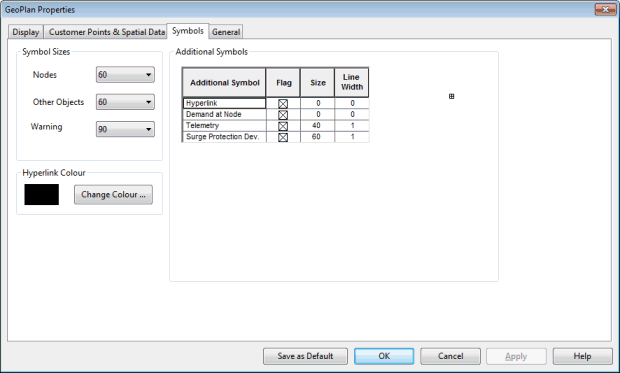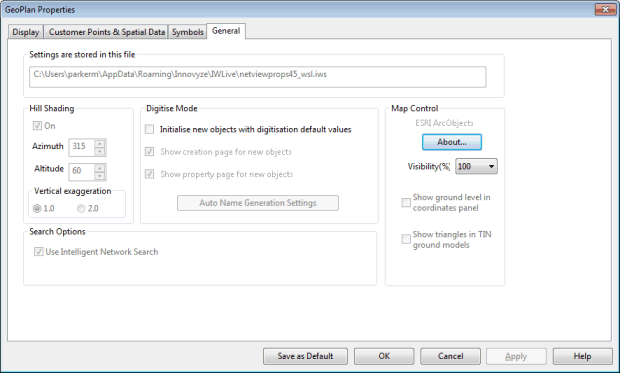Map View Properties dialog
The GeoPlan Properties dialog allows changes to be made to the display options for the Map view .
The Map View Properties dialog is displayed by selecting Properties from the Tools menu.
- The Display Page is used to edit network object display settings including colour and line width.
- The Customer Points and Spatial Data Page is used to set display parameters for customer points and spatial data (only displayed when properties dialog is opened from the Baseline Page) .
- The Symbols Page is used to change the size of the network object symbols on the Map view . Size ranges from 30 - 100 with 60 being the original default size. (This tab is only displayed when the properties dialog is opened from the Baseline Page.)
- The General Page is used to view Map Control settings and to set the visibility of background layers.
Use the Save as Default button to save the settings in the dialog. They will be used for all map views opened from now on. The settings that have been made on all the tabs of the property sheet will become the default settings for future map views in both the Admin and Operator modes . Use the Save as Default button with care.
Display Page
The Display Page is used to edit network object display settings. Objects and labels can be displayed or hidden; colours of object types can be changed and width of line objects set.

When viewing properties for the Headlines page, only the Baseline polygon properties can be edited. When viewing properties for Baseline pages, properties of all network objects can be edited.
| Option | Description |
|---|---|
| Layer | Network object type |
| Show | Use the Show box to turn display of network object layer (including labels) on and off. |
| Auto Label | Check the Auto Label box to turn on display of auto labels. (Auto labels are configured in InfoWorks WS Pro. |
| Label Theme | Check the Label Theme box to turn on display of the parameter displayed by the currently active theme. |
| Symbol | Use the Symbol box to turn display of network object symbol on and off. (Labels will still be displayed.) |
| Colour | Select the colour in which the object type is to be displayed. |
| Line Width | For link objects, set a line width of between 1 and 5 pixels. If the Line Width value is zero, a default width will be used. |
| Min Zoom | Enter the minimum zoom level above which the network objects will be invisible. If the Min Zoom value is zero, a minimum zoom will not be applied. |
Customer Points and Spatial Data Page
The Customer Points and Spatial Data page is used to set the display options for Customer Points and Spatial Data in the network. This page is only displayed when viewing properties for a Baseline Page.

- Customer Point Demand Assignment - select an option for drawing links from customer points to the network
- Spatial Data Assignment - select an option for drawing links from spatial data points to the network
- Spatial Data Symbols - adjust the display of spatial data objects according to type
Symbols Page
The Symbols page is used to change the size of the network object symbols on the Map view . This page is only displayed when viewing properties for a Baseline Page.

- Symbol Sizes - change the size of the network object symbols on the Map view . Size ranges from 30 - 100 with 60 being the original default size.
- Hyperlink Colour - set colour of symbol used to denote whether object has hyperlinked data (See Hyperlink Additional Symbol below).
-
Additional Symbols - options to add special symbols to the
Map view
to show:
-
Hyperlink - With this option switched on a quartered symbol is attached to the object with hyperlinked data (e.g.
 ).
).
-
Demand at Node - the node symbol changes from a
 to a
to a
 for nodes with demand.
for nodes with demand.
-
Telemetry - a special symbol
 is attached to a network object to indicate that it is linked to telemetry and that it is updated from live data before simulations are run (i.e. one of more live data feeds are specified for that network object in the Fields window).
is attached to a network object to indicate that it is linked to telemetry and that it is updated from live data before simulations are run (i.e. one of more live data feeds are specified for that network object in the Fields window).
-
Surge Protection Dev - the
 symbol is attached to nodes that have surge protection devices.
symbol is attached to nodes that have surge protection devices.
 InfoWorks Transient System
InfoWorks Transient System
The Surge Protection Dev symbol relates to functionality available in InfoWorks Transient System (TS), which is a module of InfoWorks WS Pro. InfoWorks Transient System (TS) functionality is only available if the InfoWorks TS option is enabled on your InfoWorks WS Pro licence. Contact us for information about adding this option to your existing licence.
-
Hyperlink - With this option switched on a quartered symbol is attached to the object with hyperlinked data (e.g.
Some or all of these symbols may not be visible if you have turned off symbols for the particular object type on the Display Page. Simply click in the appropriate check box on the Symbols column to turn the symbols on or off.
Please note that symbols may be displayed in different colours but this has no significance. The colour is taken from the underlying symbol colour for the object.
General Page
The General Page shows basic information about the Map view, digitisation modes and the current Map Control.
The majority of options on the General page are disabled. Disabled options are applicable to InfoWorks WS Pro, but not IWLive Pro Operator Client.

Settings are Stored in this File
The Settings are stored in this file box displays the file where the Map view properties are stored. When the Default button is clicked, the settings from all the pages on the dialog are saved to this file. The filename cannot be changed, and the location will always be the same relative to your Windows installation. The name is given for information, in case you want to back up the file, or copy the file to a different IWLive Pro Operator Client installation. You should back up the existing settings file before replacing it.
Hill Shading
In InfoWorks WS Pro, hill shading is used to emphasise the contours of a ground model displayed on the GeoPlan view. Hill shading simulates a light source (the sun) which you can point towards your model:
- from any direction around the horizon
- from any angle between horizontal (0°) and directly overhead (90°).
You can also exaggerate the vertical scale to make contours stand out more clearly.
- use the On check box to switch hill shading on and off
- set the horizontal angle in the Azimuth box. 0° means the light source is pointing from the top of the view.
- set the vertical angle in the Altitude box. 90° is directly overhead
- set the Vertical Exaggeration to give the best effect
The best effects from hill shading need to be found by trial and error, and will vary depending on the ground model.
Digitise Mode
You can turn on the various digitisation options on this page in InfoWorks WS Pro. These allow you to add nodes and pipes rapidly in InfoWorks WS Pro without having to add data to each object as it is created.
- Initialise New Objects with Digitisation Default Values - check this box to use defaults for newly created network objects.
- Show Creation Page for New Objects- uncheck this box to prevent the object naming dialog being displayed after the object is created.
- Show Property Page for New Objects- uncheck this box to prevent the object property sheet being displayed after the object is created.
Current Map Control
The General page displays the name and version of the currently selected Map Control. Click the About button to view the About Box for the current Map Control.
Map Backgrounds in the Map view can be faded using the Visibility(%)dropdown. This setting does not affect printing, in which map backgrounds are always at 100% visibility.
Spot Ground Heights
A checked Show ground level in coordinates panel box indicates that the ground level will be displayed on the Status Bar when there is a Ground Model loaded in the GeoPlan in InfoWorks WS Pro.
TIN Ground Model Triangles
A checked Show triangles in TIN ground models box means that the outlines of the underlying triangles that make up a TIN ground model will be displayed.
Search Options
Check the Use Intelligent Network Search box to bypass the display of the Multiple Selection dialog when selecting objects on the GeoPlan where different object types overlay each other.
For example, with Intelligent Network Searchturned off, clicking a node connected to links will display a selection dialog list of the node and connected links. With Intelligent Network Search turned on, clicking the node will select the node only.
